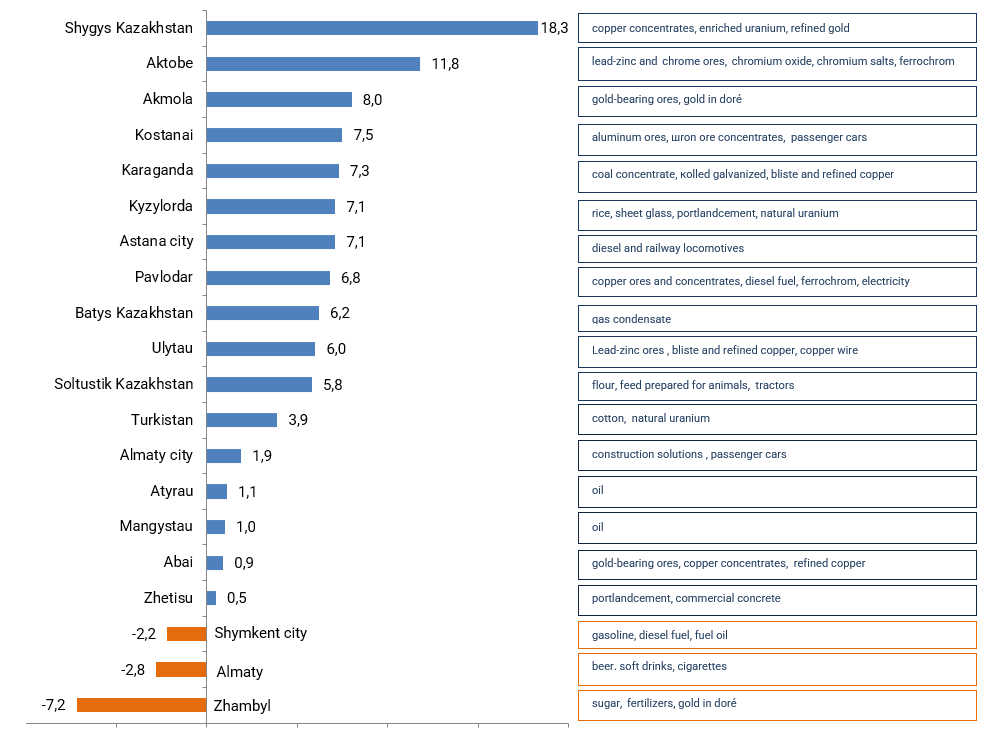Production growth is observed in the mining industry and quarrying by 1.9%, manufacturing industry – by 7.4%, supply of electricity, gas, steam, hot water and air conditioning – by 4.9%, water supply; water disposal; collection, treatment and disposal of waste, activities for the elimination of pollution - by 3.8%.
Among the regions, the largest growth was recorded in Akmola, Aktobe, Shygys Kazakhstan regions.
In January- February 2024, industrial products were produced in the amount of 7502.7 billion tenge, of which in the mining industry - by 3566.7 billion tenge (47.5% of the total volume), in the manufacturing industry - by 3237.9 billion tenge (43.2%).

| January 2024 by January 2023 | February 2024 to | January- February 2024 by January- February 2023 | ||
|---|---|---|---|---|
| January 2024 | February 2023 | |||
| Industry | 103.4 | 103.8 | 105.7 | 104.6 |
| Mining and quarrying | 100.2 | 98.9 | 103.6 | 101.9 |
| Manufacturing industry | 106.9 | 109.2 | 107.9 | 107.4 |
| Supply of electricity, gas, steam, hot water and air conditioning | 102.5 | 101.9 | 107.3 | 104.9 |
| Water supply; collection, treatment and disposal of waste, activities for the elimination of pollution | 104.8 | 108.4 | 102.8 | 103.8 |
In the mining industry and quarrying in January-February 2024 the IIP was 101.9%, due to an increase in the production of metal ores (107.2%), other minerals (102.9%) and services in the mining industry (106.9%).
In the manufacturing industry, the IIP in the reporting period 2024 compared to the period of 2023 107.4%, The growth was recorded in the production of chemical industry products – by 25.3%, metallurgical - by 10.6%, finished metal products, except machinery and equipment – by 24.3%, mechanical engineering - by 23.4%, other finished products – by 1.8 times.
In the supply of electricity, gas, steam, hot water and air conditioning the IIP amounted to 104.9% due to an increase in the production, transmission and distribution of electricity by 7.5%.
In water supply; water disposal; collection, treatment and disposal of waste, activities to eliminate pollution the IIP in January-February 2024 amounted to 103.8%. Collection, treatment of waste water by 5.5%, collection, processing and disposal of waste, recycling (resovery) of materials – 4.9%.
An increase in production volumes was recorded in 17 regions of the republic, a decrease is observed in Almaty, Zhambyl regions and Shymkent city.

The volume of industrial production in value terms is the cost of all finished products (products) produced by the enterprise, semi-finished products of its production (both from its own raw materials and materials, and from raw materials and materials of the customer), intended for sale to the side, its capital construction and its non-industrial divisions, issuing to its employees on account of wages, as well as works and services of an industrial nature, performed on orders.
The volume of industrial production in physical terms is the output of specific types of products in physical terms. The volume of industrial production in physical terms is taken into account in terms of gross output, including products spent on industrial and production needs within a given enterprise and produced from raw materials supplied by the customer.
The index of industrial production is a relative indicator that characterizes the change in the volume of industrial production in the periods being compared.
The information base for the formation of indicators of industrial products (goods, services) is the primary data of nationwide statistical observations of industrial enterprises, enterprises with a secondary activity of "Industry", individual entrepreneurs, peasant or farm enterprises.
To calculate the index of industrial production, a method is used based on the dynamics of physical indicators for an established set (basket) of representative goods, followed by a step-by-step aggregation of individual (commodity) indices into indices by types of economic activity. Indices for large populations are calculated as a weighted average of the constituent elements of these populations.
More detailed methodological explanations are available at the following links: